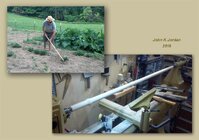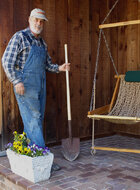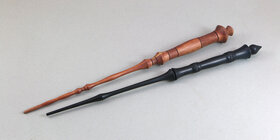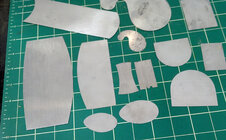I've not done much spindle work. I was recently tasked with turning something (about 18"x1") and found that I was getting a wavy look vs a nice smooth finish. I suspect this was from flex in the piece as I was working it. Is that correct? Any suggestions to minimize or avoid it? Thanks
-
December 2025 Turning Challenge: Single Tree! (click here for details) -
Congratulations to Bob Henrickson, People's Choice in the November 2025 Turning Challenge (click here for details) -
Congratulations to Dave Roberts for "Low Rider" being selected as Turning of the Week for December 1, 2025 (click here for details) -
Welcome new registering member. Your username must be your real First and Last name (for example: John Doe). "Screen names" and "handles" are not allowed and your registration will be deleted if you don't use your real name. Also, do not use all caps nor all lower case.
You are using an out of date browser. It may not display this or other websites correctly.
You should upgrade or use an alternative browser.
You should upgrade or use an alternative browser.
"waves" on spindle turnings
- Thread starter Cary Hulse
- Start date
- Joined
- Feb 28, 2021
- Messages
- 1,760
- Likes
- 1,573
- Location
- Roulette, PA
- Website
- www.reallyruralwoodworks.com
Sharpen your gouge... sounds like you're pushing too hard on the bevel, which usually happens when someone's trying to make the gouge cut wood when it gets dull. (Been there, done that)
Roger Wiegand
Beta Tester
Finish turning the center first before thinning the ends. Reduce your tailstock pressure to the minimum needed, too much and you will bow the piece. Or hold one end in a chuck and only use the centering pin on your tailstock-- little or no pressure. Gentle cuts with a sharp tool, push too hard and you will bow it. Support the cut with fingers on the back side when working towards the middle. Once the chatter starts change the speed of your lathe-- faster or slower-- to get away from the resonance frequency and take very light cuts. Try a skew rather than a gouge, most spindle turning cuts, deep coves excepted, are easier and cleaner with a wicked sharp skew. All else fails get out the 80 grit gouge. ;-)
Thanks to both of you.
This was mainly with a skew, but I haven't mastered the sharpening of it yet so I'm sure it wasn't quite "wicked sharp", and now I do think I had too much pressure on the tail center.
Much appreciated
This was mainly with a skew, but I haven't mastered the sharpening of it yet so I'm sure it wasn't quite "wicked sharp", and now I do think I had too much pressure on the tail center.
Much appreciated
18" is a very long 1" spindle piece that would set any of us up for problems. You'd need nearly perfect technique. And a dull or improperly sharpened skew would not get you there.
All very good advice! 18" is long for 1" diameter. Definitely start from the center then complete toward the tailstock before working toward the headstock. Holding one end in a chuck will certainly help -- I usually use a chuck for lengths >12" for this diameter. Supporting from the back with your fingers will help.Finish turning the center first before thinning the ends. Reduce your tailstock pressure to the minimum needed, too much and you will bow the piece. Or hold one end in a chuck and only use the centering pin on your tailstock-- little or no pressure. Gentle cuts with a sharp tool, push too hard and you will bow it. Support the cut with fingers on the back side when working towards the middle. Once the chatter starts change the speed of your lathe-- faster or slower-- to get away from the resonance frequency and take very light cuts. Try a skew rather than a gouge, most spindle turning cuts, deep coves excepted, are easier and cleaner with a wicked sharp skew. All else fails get out the 80 grit gouge. ;-)
I generally use a spindle detail gouge rather than a skew. A detail gouge has a heavier shaft, so it is less likely to vibrate than a regular gouge, especially for deeper cuts when you have greater length beyond the tool rest.
A spindle steady *might* help, but reduced pressure from your tool and tailstock will likely help more. I rarely use a steady, even for longer spindles, but always a chuck.
I've turned 29" back posts for Windsor chairs -- maximum diameter ~1 1/2" but as little as 5/8" diameter in the middle. Holding one end in a chuck provides much more support than a drive center. A spindle steady may help, but I've found that finger support from the back is usually enough.18" is a very long 1" spindle piece that would set any of us up for problems. You'd need nearly perfect technique. And a dull or improperly sharpened skew would not get you there.
Despite its name, a spindle roughing gouge is good for shaping and can leave a very fine surface when cutting long curves, if you use bevel support. A continental gouge is also good.
And it's relatively easy to sharpen.spindle roughing gouge is good for shaping and can leave a very fine surface
I am not a spindle turner, but a friend is. He commented once that spindles in the 10 to 1 ratio will stay pretty steady. So, 1 inch diameter 10 inches long will be pretty steady. Longer, and/or thinner and you start getting some whipping action. It can be done, but as some one said, "the bevel should rub the wood, but the wood shouldn't know it". Very gentle bevel rub! "Just enough tailstock pressure" is good too. Some even put chucks on the tailstock and put the spindle under pull tension. Sharp tools, of course, and I do strop my skews to remove the burr.
robo hippy
robo hippy
- Joined
- Apr 27, 2004
- Messages
- 9,301
- Likes
- 6,055
- Location
- Lakeland, Florida
- Website
- www.hockenberywoodturning.com
Despite its name, a spindle roughing gouge is good for shaping and can leave a very fine surface when cutting long curves, if you use bevel support. A continental gouge is also good.
We used to see a guy from the Rawlings company about every year outside Camden yards.
They had a lathe in a trailer with a viewing area.
The Rawlings guy would turn a bat from square to finished bat it about 10 minutes using only an SRG.
He turned the knob with the flute down.
I’m’ sure he was moving a lot slower than his normal speed because he was talking about the process
The only part not totally finished with the SRG was the barrel end of the bat. He had a machine that carved out the end a little.
During the day he worked with the ball players who were Rawlings customers - turning bats for them and tweaking dimensions and weights.
I’m a fan of the continental gouge.
I've not done much spindle work. I was recently tasked with turning something (about 18"x1") and found that I was getting a wavy look vs a nice smooth finish. I suspect this was from flex in the piece as I was working it. Is that correct? Any suggestions to minimize or avoid it? Thanks
Cary, I echo what others said - flexing from pressure from the tool is the biggest problem with long spindles. You HAVE to prevent the flexing. Sharp tools and other support are needed, more so if the spindle is thin. I've turned long tool handles and a bunch of very thin spindles over the years. I don't use a stead rest other than the "left hand steady rest."
For a thin spindle sharp is vitally important. Good tool control is important. Secure support on the headstock end is important (chuck or other method, not between centers.)
But support down the length is necessary - and the support has to move down the wood as the tool is moved. Some people use steady rests but I've never used one - no need for spindles. I support lightly with my left hand directly behind or near the cutting edge (depending). The left hand should not get hot from the friction. Richard Raffan said once that if the supporting hand gets hot you are pushing too hard with the tool!
This hickory handle for my favorite shuffle hoe is a "thin" spindle. My 3520b has a bed extension and even then I had to move the headstock and tailstock until they were half off the ends of the bed. And due to the length I had to use a drive center instead of a chuck.

I've turned several shovel handles - all needed good support down the length.

And 100s of "magic" wands - only 13-14" long but can flex like crazy if not supported!

When I do a demo on thin spindles I usually take these to show: over 24" long, tapered from about 1/2" to 1/16". Turned with a sharp skew, steadied with the left hand. One is walnut, the other, shelving pine from Home Depot. The one from walnut still has the short #2MT I use for this type of spindle. For a thicker spindle like you mention, I'd definitely use a chuck.

When I teach, even if a student has never seen a lathe before the skew is the first tool I put in their hands.. I have (knock on Bubinga) never had one get a catch. Some now are quite skilled at thin spindles.
If interested, you might take a look at the PDF document I posted here on turning thin spindles. It applies to nearly all "thin" spindles.
This document shows the tools and methods I use to hold, shape, and successfully finish a thin spindle. I wrote this update for a recent club demo.
As spindles get long and thin, there are challenges to turn them successfully. My demos use “magic” wands to show the techniques but they apply to many types of thin spindles. I always take some long examples, a couple of tapered shafts that go from about 1/2” diameter down to 1/16” diameter in more than 24” - one I turned from a piece of shelving pine board from Home Depot.
Some things covered here are about the wood itself and how to...
As spindles get long and thin, there are challenges to turn them successfully. My demos use “magic” wands to show the techniques but they apply to many types of thin spindles. I always take some long examples, a couple of tapered shafts that go from about 1/2” diameter down to 1/16” diameter in more than 24” - one I turned from a piece of shelving pine board from Home Depot.
Some things covered here are about the wood itself and how to...
- John K Jordan
- Replies: 9
- Forum: Tutorials and Tips
JKJ
Thanks everyone, this is excellent info.
Interesting idea.Some even put chucks on the tailstock and put the spindle under pull tension.
I do a lot of spindle turning but haven't tried that yet.Some even put chucks on the tailstock and put the spindle under pull tension.
I do a lot of spindle turning but haven't tried that yet.
A second chuck in the tailstock generally requires fastening a lightweight mini chuck on an adapter that screws onto a oneway-type live center. Works better for a relatively thick spindle since the inertia of the lathe starting up the second heavy chuck through the workpiece puts twisting forces on the wood which can twist a thin spindle in two - shouldn't be a problem for a 1" spindle from strong wood.
The live center, chuck, and spindle is held under tension with a drawbar, requiring a tailstock quill with an adequate through hole. The type of wood (soft/weak vs tough/strong) may be a factor. One might search for a recent thread that discussed the second chuck method in detail.
I personally have never had aneed for this since I use the "left hand steady" method to stabilize the spindle, regardless of the thickness/length ratio of the spindle. I don't own nor have ever used a steady rest. I've turned many hundreds of long and thing spindles this way of various thicknesses.
One thing I don't remember being discussed is how to recover from a spiraled wavy surface. (Without using a wide piece of 80 grit sandpaper!)
Once the first wave in one spot starts the bevel of the skew can easily "surf" up and down that wave and make more and deeper spiral waves down the length. To fix this I do something I rarely use elsewhere: instead of a normal planing with a straight edge on the skew I make a pass and cut away the wave using just the "short point" of the skew, the point closest to me. This can remove the spiral wave, leaving a straight surface on the spindle to support the skew bevel for the next passes. Has worked every time. Again, for me hand support down the spindle important. (Turning at high speed also helps)
This is far easier to show than describe!!
None of this matters, of course, for a fat spindle!
For some reason I used to get lots of these waves but not for years now. Maybe I gradually got better and correcting them before they got started. And as mentioned often, I always use one hand to support behind the cut to eliminate flexing.
JKJ
- Joined
- Apr 27, 2004
- Messages
- 9,301
- Likes
- 6,055
- Location
- Lakeland, Florida
- Website
- www.hockenberywoodturning.com
AbsolutelyA second chuck in the tailstock generally requires fastening a lightweight mini chuck on an adapter that screws onto a oneway-type live center. Works better for a relatively thick spindle since the inertia of the lathe starting up the second heavy chuck through the workpiece puts twisting forces on the wood which can twist a thin spindle in two
What I have seen done with thin goblet stems is to tape the cup to the live center and apply tension.
It is almost a necessity is to have a a wad of paper towel or a small ball in the cup and use the tailstock to prevent the cup from whipping around.
I’ve used this a few times after seeing Stewart Batty do it with a crumped up paper towel in the cup and applying tension to turn an 18” thin stem on a goblet.
- Joined
- Feb 6, 2010
- Messages
- 3,445
- Likes
- 2,512
- Location
- Brandon, MS
- Website
- threeringswoodshop.square.site
You can try using a skew in scraper orientation, but be careful as this can create a rough surface.
Another way I sometimes use to smooth irregularities in very thin spindles or stems is with a small hand scraper. Properly sharpened, held at a small angle to the wood, and sometimes easier scraping with the lathe in reverse, sometimes forward. I try different things and see what works best.
Usually one of the smaller ones similar to these, sometimes with rounded corners.

Here's a rectangular one in use on a thin spindle. These, BTW, are sharpened just like a cabinet scraper. I stabilize the spindle with my fingers to counteract the light pressure from the scraper, here with fingers of hands, keeping the scraper moving. This will clean up almost any wave or irregularity.

JKJ
Usually one of the smaller ones similar to these, sometimes with rounded corners.

Here's a rectangular one in use on a thin spindle. These, BTW, are sharpened just like a cabinet scraper. I stabilize the spindle with my fingers to counteract the light pressure from the scraper, here with fingers of hands, keeping the scraper moving. This will clean up almost any wave or irregularity.

JKJ
Maybe the waves are some thing you actually want on your turnings..... I do some times get a nice spiral pattern on the bottom center of bowls. Some times even number, some times odd and the numbers are never constant. I do like the look of the waves in bowls, and some times they look nice on spindles. The trick would be to do them intentionally! I had one bowl that when sanded out, the waves stayed, and were highlighted by a different color with the "patina" being sanded away. It sold quickly.
robo hippy
robo hippy
Maybe the waves are some thing you actually want on your turnings..... I do some times get a nice spiral pattern on the bottom center of bowls...
In my experience the problem with spiral "waves" on spindles, especially thin spindles, are not controllable. I've admired short sections but they weren't at the place and diameter to be useful. I've learned to NOT make them, but maybe I could try making some on purpose.
